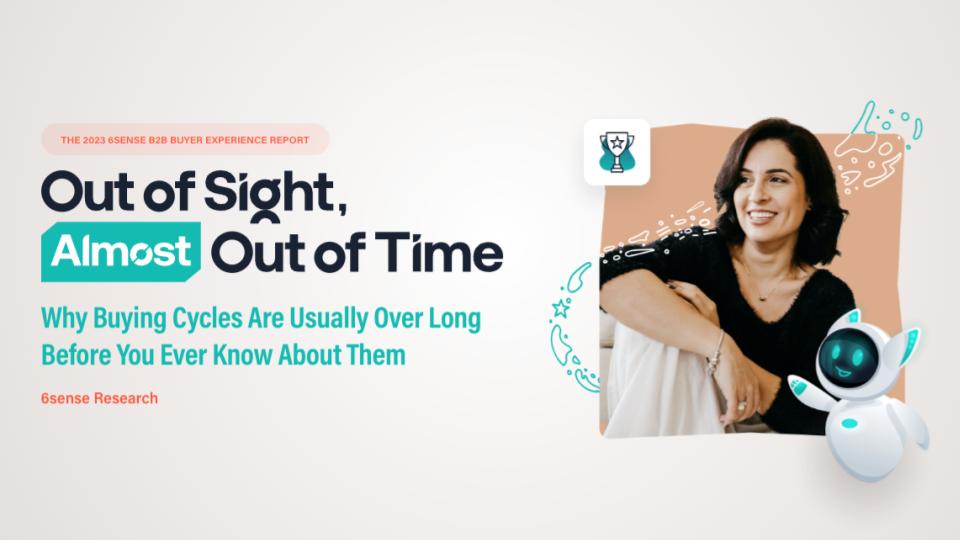What if your revenue team could predict with ultra-high probability which prospects were likely to convert, and — more significantly — when they would convert?
Armed with that knowledge, your team would pursue only the most profitable, likely-to-close accounts. And your marketing team could ditch the desperate contact forms on your website. And your salespeople would only contact buyers who were ready to learn about your solution at that moment, and not a minute sooner.
No spam. No cold calls. It sounds like fiction … but it isn’t. Not when you know your company’s In-market Ideal Customer Profile, or IICP.
The difference between an IICP and the better-known concept of ICP (Ideal Customer Profile) is significant, and can make all the difference in defining the efficiency, impact and success of your revenue team.
Let’s take a closer look at this unique approach to account targeting, and unpack how it can dramatically improve the way your team sells.
What’s an IICP, Anyway?
Your organization’s IICP has a lot in common with a traditional Ideal Customer Profile (ICP). Based on shared firmographic attributes and other factors, these are prospects that:
- Are most likely to buy from you
- Most likely to be profitable for you
- And most likely to be satisfied with your solution
But success is in the details, and there’s one element to an IICP that a conventional ICP doesn’t have. Defining an IICP factors in the dimension of timing. (That’s what the “In-market” part of IICP refers to.) At its simplest:
Your IICP identifies prospects that are likely to buy your solution, and are likely to buy it now.
By limiting the scope of your addressable market from likely buyers to highly interested buyers, your revenue team can reliably dedicate the right kind of money, effort and resources to the accounts that are always most likely to convert.
How to Determine Your Ideal Customer Profile
We’ll zero in on how to identify your In-market Ideal Customer Profile in a moment, but let’s level-set by aligning on how to determine your traditional ICP. This requires taking a close look at your closed-won accounts and finding the commonalities between them, such as:
- Industry
- Company size
- Geographic location
- Number of employees
- Revenue
Also see if any other features stand out, like technology platforms or solutions they’re already using, or if they were previously the customer of a competitor.
With enough data, patterns will emerge … and they’ll help inform the creation of a traditional ICP.
Now to Determine Your IICP
It’ll take more than firmographic data to successfully spot the accounts in your IICP. Intent data and predictive data are required to identify when prospects are ready to buy.
Savvy revenue teams use ABM-centric account engagement platforms, with AI operating at their cores, to extract these crucial clues. Their automated processes, complemented by machine learning, radically reduce the time, effort and costs associated with determining the criteria of in-market prospects.
Revenue teams can try to make similar calculations and educated guesses on their own, but it won’t be easy. (If not impossible.)
Theoretically, you could use a mix of touch-timing reports and content engagement analytics to try to decipher when an account ends up in-market. However, this would require an astonishing amount of effort to analyze, and would be outdated as soon as your marketing team publishes new content.
To make matters more complicated, data can only be generated and analyzed in a linear fashion, and customers can quickly move back and forth between stages in the buying journey. Some days they’re ready to buy, some days they aren’t.
Using the manual approach, a buyer may have already changed their mind even before the analysis is done. That’s not a good look.
Knowing the Right Timing Saves Time
It’s clear that the one factor we’ve been discussing — timing — can often define the fate of a deal. Knowing your IICP gives your sales and marketing teams the highest odds of success, because they are targeting the best opportunities at exactly the right times.
And speaking of time: Targeting accounts based on IICP will save your revenue team a lot of it. Consider this traditional approach to buyer outreach:
- A potential buyer visits your company’s website
- The buyer spots an interesting white paper,
- In order to download it, they’ll need to complete a form-fill
- More than 90% of buyers bounce at this point, refusing to provide their contact info
- However, this time the buyer opts in to download the asset
- Your revenue team actually gets their contact information
- The buyer is probably flagged as an MQL (even though it’s unclear how interested in your solution they actually are)
- Now it’s time for a BDR to blast the buyer with repeated phone calls and emails
If your organization is against-all-odds really lucky, the outreach is well-received and the account eventually becomes a closed-won.
We all know this doesn’t often happen, because sales success depends on timing.
Successful deals hinge on buyers being in a sweet spot where they’re ready to buy. Ill-timed emails and calls are more likely to be seen as spam than a helping hand. Your competition is suddenly looking a lot more attractive.
Defining an IICP — again, that “in-market” component is so critical here — enables you to skip all that effort and drama. When your revenue team targets and connects with accounts that are ready to hear your message, your buyers won’t gripe about the outreach. They’ll be very happy to accept those calls, emails, white papers, and ebooks.
More importantly, all the world-class assets that your content team has spent so much time crafting don’t have to hide behind forms. You can give away that stuff with impunity because your IICP helps ensure that your sales team will only reach out to relevant accounts.
Brass tacks: Your revenue team will smartly use its time pursuing in-market opportunities instead of desperately chasing any account that might look like a potential buyer.
Conclusion
As we mentioned, defining the “in-market” component of an IICP can be challenging, and doesn’t play nicely with a DIY approach.
The best way to determine your IICP is to use technology that captures intent signals at the account level and uses predictive AI-driven models (informed by historical and real-time data) to identify where accounts are in their buying journeys.
World-class account engagement platforms (like 6sense) can save your revenue team even more time by eliminating guesswork into which accounts should be targeted with what content. They help revenue teams prioritize efforts on the accounts most likely to convert now.






